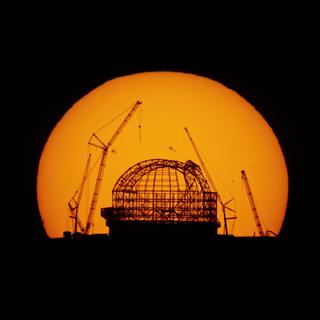


On the construction site of the world's biggest telescope
FeatureThe ESO's Extremely Large Telescope will be the world's biggest. The skeleton of the immense 80-meter-high dome has passed the halfway mark of its construction.
A landscape of sky and stone, turquoise and ocher. This is the Atacama, the foothills of the Chilean Andes. A desert drier and rougher than a brick, where nothing grows except, these days, fields of solar panels, electricity pylons, giant factories processing lithium and other minerals. Here, the main player is the wind, which raises red, grey or white dust, erodes the mountains and transforms them into bare hillocks from which nothing flows except scree, streams of rocks cutting into the slope and leaving lighter gashes. An omnipresent wind stubbornly strips the rare billboards and frantically shakes the black plastic bags crucified on barbed-wire fences.
Little by little, the last traces of human society grow scarcer. "Magnificent desolation," said American astronaut Buzz Aldrin as he stepped out of the lunar module to join Neil Armstrong on the Apollo-11 mission in July 1969. The phrase can be repeated here, even if the landscape is more reminiscent of Mars than the Moon. The road plunges monotonously into the heart of the desert and suddenly, in the distance, it appears. An openwork dome, sitting on top of a hill like a steel cherry on a plump cake. Seen this way, from miles away, it looks very small. But in fact, it is quite the opposite: the ELT is enormous. Its name says just that: The Extremely Large Telescope will become the world's most imposing telescope when the European Southern Observatory (ESO) commissions it in 2028. It will be the new flagship of this organization, of which Germany, the UK, France and Italy provide over 60% of the budget alongside 12 other European countries. Australia and Chile are also associated with the telescope.
The ELT, a €1.3 billion project, is rising out of the ground. The first phase consisted of blasting away the summit of Cerro Armazones, at an altitude of 3,046 meters: some 220,000 cubic meters of rock were removed to make way for a long concrete platform. The skeleton of the immense 80-meter-high dome, under which the façade of Notre Dame could fit but which will house the telescope, is now well advanced.
Extreme UV index
Anyone wishing to visit the site is required to take a few precautions, which go far beyond simple hard-shell shoes, helmet and fluorescent vest. As the atmosphere is less dense due to the altitude, the UV index can climb to an extreme 11. One needs gloves, sunglasses and sunscreen. Many workers wear a litham to protect them from both the sun's rays and the wind, which can easily exceed 80 km/hour.
You have 80% of this article left to read. The rest is for subscribers only.
